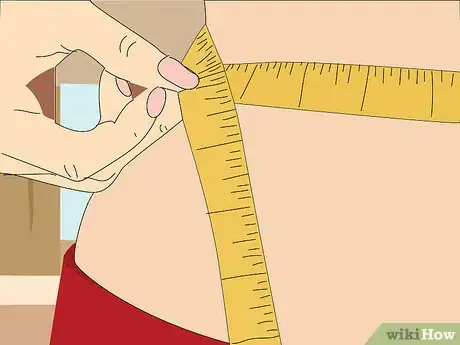This article was co-authored by Melynda Choothesa. Melynda Choothesa is a Costume Designer, Wardrobe Stylist, and Art Director with over 10 years of fashion consulting experience. She has worked on creative direction for fashion shows, costume design, and personal wardrobe styling, both in Los Angeles, California and internationally for clients such as Akon, Kathy Ireland, and Aisha Tyler. She has an Associate of Arts in Fashion Design from Santa Monica College.
wikiHow marks an article as reader-approved once it receives enough positive feedback. In this case, 100% of readers who voted found the article helpful, earning it our reader-approved status.
This article has been viewed 130,413 times.
Although JCPenney may not be the first employer of models that comes to mind, the nationwide retailer releases weekly store ads as well as seasonal catalogs, making them a steady source for jobs around the country. However, the company does not list openings for modeling opportunities on its online career pages, which may leave potential applicants wondering how to get their foot in the door. By contacting JCPenney, getting an agent, and putting together a portfolio, you too can pursue a career as a JCPenney model.
Steps
Contacting JCPenney
-
1Call corporate on the telephone. Although the department store chain is nationwide, the company's headquarters are located in Plano, Texas. You will need to call or email their corporate headquarters to find out who to get in touch with locally (and what number or email you can reach that local contact at) for more information about modeling opportunities. The online website for careers at JCPenney does not have any listings for models, so unfortunately you cannot use their website to get a job this way.[1]
- Corporate's phone number is (972) 431-1000.[2]
- Corporate's fax number is (972) 431-1362.
- Ask them for the number of the local administrative office and the name and title of the person you need to speak with regarding modeling opportunities. Be sure to be polite (say please and thank them for their time).
-
2Call your local administrative office. You need to find out whether or not your local JCPenney is looking for new models, and how they go about hiring models. Ask if they cast for the models themselves, if they will only take models that have agents to vouch for them, and whether or not they go through a particular agency in the area. If your JCPenney hires directly, ask for an email or snail mail address that you can send a portfolio to and find out what specific requirements they have for talent submissions.
- There is a high likelihood that your JCPenney will only take models from approved agencies for both their catalogs and printed ads, so be prepared to ask for the names of the agency or agencies that they have a professional relationship with, as well as their phone numbers and physical addresses.[3]
- Ask questions to find out the criteria that they are looking for in current models; the look a company is looking for can change over time.
Advertisement -
3Contact the agencies JCPenney uses. If you've been told that your JCPenney only does business with select agencies, you will need to go through one of these organizations in order to work with JCPenney. If you live out in California, there is a list of approved agencies that JCPenney uses online. They include:
- Elite Management
- Jet Set Management
- L.A. Models
- Nouveau Model & Talent
- Shamon Freitas Agency
- Wilhelmina Models, Inc.
- Everyone else will need to contact the local administrative offices for JCPenney to find out who they work with.
- You need to find out their specific submission guidelines, what address to send submissions to, and what looks they're looking for.
-
4Submit your portfolio. If you've been told you can go directly through JCPenney's offices, submit your portfolio to them. It should showcase several of your best photos. Be sure that you follow whatever instructions you were given for submissions exactly and submit any extra information they may ask for like your age and body measurements.
-
5Watch for opportunities. Sometimes announcements for fashion show opportunities at local malls pop up, so you'll want to keep an eye out for these. You can follow JCPenney's Facebook and Twitter accounts to watch for these opportunities, as well as checking websites like Paidmodeling.com and Backstage.com to watch for events. You can also stop by your local JCPenney's to inquire with the staff about a calendar for events like fashion shows and other similar opportunities.
- Ask a salesperson for an event calendar. If they do not have one or know of one, ask if they can call a supervisor to a register to give you one.
- JCPenney also occasionally hosts modeling competitions at local and national levels; keep an eye out for these while watching the various online pages, and submit to them whenever you have the opportunity.
- Even if you are not able to actually model in a show, attending one as a viewer will give you the opportunity to approach either the models or someone hosting the event to inquire for more information and get your face and name out there. Introduce yourself and ask them how models get started with JCPenney and to whom can you submit your modeling portfolio for consideration. Again, remember to be polite.
Getting an Agent
-
1Obtain parental approval. If you are legally a minor (that is, under 18 years old) you will have to get your parents' approval before you can sign on with an agency. There are a lot of benefits to having your parents' approval as well, like emotional support for stress management and the ability to get to your assignments.
- Have a discussion with your parents. Explain to them why you want to be a model, and why you need an agent. "I think that I could have a lucrative career as a model for JCPenney. They have a good reputation and there are stores across the nation, so I could live and work with them anywhere in the future. However, in order to work for them, I have to have an agent to get me into the door, and I can't sign any contracts until I'm 18. Please help me get an agent and start my modeling career."
- Talk with them about what their support will mean for you on a personal level. "I know that what I want to do is going to be very time consuming and demanding on me. Without your support to take me places and help me manage my homework and professional life, I will have a very difficult time succeeding. This means the world to me."
- If you don't get what you want initially, treat the conversation with maturity: don't yell, cry, or otherwise throw a tantrum. You want to show them you're mature enough to handle working, and this is part of that. Instead, ask when you might be able to revisit this conversation with them in the future.
-
2Avoid scams. There are many illegitimate agencies out there looking to take advantage of individuals' hopes and dreams. A real agency won't ask for money from you unless you're making them money, and that includes signing fees or costly modeling classes or workshops. You should look for agents that have long-standing reputations and are large and well-known.[4]
- The top 10 modeling agencies are Next Model Management, One Management, Women Management, Storm Management, Elite Model Management, Marilyn Agency, DNA Models, IMG Models, Model Management, and Ford Models.
-
3Pick an agency that JCPenney works with. Ask the nearest administrative office for JCPenney which agencies they work with. Since you want to work specifically with JCPenney, it will be quicker if you can successfully apply to an agency that works with them.
- Do not get discouraged if you are initially rejected from the agency or agencies that JCPenney works with. You can always apply again in the future after you have built up your portfolio more.
- Let them know, after you have signed with them, that you want to work with JCPenney as much as possible and that you would appreciate their assistance in achieving that goal.
-
4Pick an agency not contracted with JCPenney. If you are turned away by an agency that works with JCPenney, apply to other agencies first in order to get jobs that will help build your reputation and name recognition before trying to switch representation. In addition to the top ten agencies listed before, you can find more modeling agencies and casting calls listed at Backstage.com and Models.com.
- Be prepared to take jobs that are not related to JCPenney's work. Building your skills and name recognition is not a bad thing, and doing so will make you a more attractive applicant for your real end goal.
-
5Follow submission guidelines. Every agency has different requirements for desired looks and guidelines which you will be expected to follow perfectly. Some of these guidelines may prohibit things like hats, bows, sunglasses, and food or face paint on your face, but these are just examples and not an exhaustive list.[5]
- The changing market will have an effect on the demand for models; currently many clients are seeking models with more ambiguous features that reflect the diverse populace as opposed to blonde-haired, blue-eyed models.
-
6Have a good attitude. It is important that you be very well-behaved, polite, discreet, and flexible with the agency during any in-person meetings during the application process as well as once you are contracted.[6] No one likes to work with a diva, so a bad attitude or an inability to make it to an appointment on time (or worse, failure to book any appointments due to distance) can cost an agency (and yourself) opportunities. It can also cause them to lose face with a client and make them reluctant to use you, and done enough, potentially drop you.[7]
- If you are a minor with parents, or parents seeking representation for a minor, this also includes the parents.
- Do not brag too much or exaggerate your abilities: be honest about what you can and can't do.
- Modeling is a career that is notorious for last-minute jobs. Be prepared that if you want to pursue this career, even if your eventual dream is to work with JCPenney, you will have to deal with this.
- Because of last minute tendencies, agencies often prefer to work with talent that lives close so that if work comes up at the very last minute, their talent can still take the job. Being more than 45 minutes away from the town with most of the work could pose a problem.
- Always bring a positive attitude to a set because you never know what connections the client you're working with might have within the industry.[8]
-
7Submit your portfolio. Either submit this to the appropriate email as provided on the agency's website online, or submit it to a physical address. Because of how busy agencies are, it's generally recommended that you wait patiently and do not contact them with phone calls or emails to ensure that they've received your submission. Instead, if you haven't heard from them within six months, try again.[9]
- If you are submitting documents to a physical address, be sure to send copies of all of your documents to them and not the originals. This is in case you need to resubmit or decide to submit to another agency later on.
- It can take a long time to hear back from an agency due to the volume of applications they receive. Be patient; if you don't hear anything back within 6 months, resubmit, but do not try to call or email the agency about the status of your application.
-
8Sign a contract. Before you sign anything, make sure that you read the contract carefully. Do not read it alone, but with your parents or legal guardian, and maybe even a lawyer if you all are struggling to understand anything. Be sure to ask questions about anything you don't understand. Once you have signed with the paperwork, the agency will start signing you up for auditions and assignments.
- You can ask for a copy of your contract for your own personal records.
- Make sure you're clear about your expectations and boundaries before signing anything.[10]
Putting Together Your Portfolio
-
1Find a photographer. You're going to need someone to take pictures for you. Although many cameras these days are high quality, it's preferably to take DSLR grade photos over selfies with point-and-shoot or phone cameras. Photographers are trained to understand framing, lighting, and can help direct you in posing for optimal shots.[11]
- Ask them if they'd be willing to do "time for print," which means that you allow them to use any photos that they take of you for their professional portfolio as well. This can be a mutually beneficial arrangement for all parties involved as it spares you the cost of having to pay for professional shots.
- Look in the phone book for small photography studios or go to a local college and ask around the art department for photography students. You can also try doing a search on the internet in a search engine like Google or Bing using keywords like "photography near me."
- If you can't get a professional or even a student photographer to do your photos for you, you could ask a friend or a relative who is good with a camera to take shots of you.
-
2Get some pictures. You will need both headshots and three-fourths shots (that is, photos from your thighs up) for this. For each shot, you should get pictures that feature two looks: minimal to no makeup on and a styled and made up look.[12]
- Explain to your photographer exactly what you're looking for before you start shooting so that you don't waste their time.
- Take your pictures up against a plain, white wall. Your skin color will look different depending on the surrounding colors, so it's best to make sure you have a neutral color framing you.
-
3Take your measurements. You will need to take your measurements at your waist, bust, and hips. Although an agent may be able to make a general guess if you are within the size range that they are looking at for girth, they won't be able to tell precise measurements (which they'll need to refer you to clients) if you don't tell them. The same is true for your weight, height, dress size and shoe size, all of which they'll need.[13]
- Wear your regular underwear or a bathing suit to get the most accurate measurements (since you will have to wear underwear underneath any clothes you're modeling).
- To get your bust size, measure with your arms down across the fullest part of your bust. This should be located under your arms and go straight and even across your back and shoulder blades. Be sure not to pull the measuring tape tight.
- To find and measure your natural waistline, bend slightly to the side and find the area that creases in your abdomen (it's usually somewhere around the belly button). Loosely measure the circumference here.
- For your hip measurement, first stand with your feet together. Then wrap your measuring tape around the fullest part of your hips. Keep the tape straight and snug to avoid drooping, but not so tight that it will slip up or squeeze into your skin.
- Ideal measurements for adult models are usually 34"-24"-34", but depending on what kind of modeling you want to do there are a range of acceptable measurements you can fall into.
-
4Make composition cards. Also known as "comp cards" and "zed cards," these cards are basically a model's business card. It will include your stats that agencies might want to know, like your name, height, weight, age, and hair color, as well as your headshot on the front and smaller images on the back. They should be 8 ½ inches wide by 5 ½ inches tall and printed on quality cardstock.
- You can get these made at a printing company or stores like Staples or OfficeMax where there is a professional printing station inside the store.
Expert Q&A
-
QuestionHow should I act for a modeling interview?
 Melynda ChoothesaMelynda Choothesa is a Costume Designer, Wardrobe Stylist, and Art Director with over 10 years of fashion consulting experience. She has worked on creative direction for fashion shows, costume design, and personal wardrobe styling, both in Los Angeles, California and internationally for clients such as Akon, Kathy Ireland, and Aisha Tyler. She has an Associate of Arts in Fashion Design from Santa Monica College.
Melynda ChoothesaMelynda Choothesa is a Costume Designer, Wardrobe Stylist, and Art Director with over 10 years of fashion consulting experience. She has worked on creative direction for fashion shows, costume design, and personal wardrobe styling, both in Los Angeles, California and internationally for clients such as Akon, Kathy Ireland, and Aisha Tyler. She has an Associate of Arts in Fashion Design from Santa Monica College.
Professional Stylist & Fashion Designer Focus on being professional. Maintain a good attitude, be polite to everyone you meet, and show you're a good team player. It also helps to convey that you're flexible and willing to work with someone else's vision.
Focus on being professional. Maintain a good attitude, be polite to everyone you meet, and show you're a good team player. It also helps to convey that you're flexible and willing to work with someone else's vision. -
QuestionCan I model if I am only 11 years old?
 Community AnswerYes, you can model at any age as long as your parent or guardian approves.
Community AnswerYes, you can model at any age as long as your parent or guardian approves. -
QuestionHow much do department store models get paid?
 Community AnswerIt depends on the store. You can consult them directly and ask.
Community AnswerIt depends on the store. You can consult them directly and ask.
Warnings
- Breaking into modeling is difficult, especially for a major retailer such as JCPenney. If this is something that you really want to do, learn to take rejection, stay on course and be persistent.⧼thumbs_response⧽
References
- ↑ http://jobs.jcp.com/
- ↑ https://corporateofficehq.com/jcpenney-corporate-office/
- ↑ http://www.hireteen.com/department-stores/jcpenney/
- ↑ http://www.dfwchild.com/features/526/Is-Your-Child-Modeling-Material#
- ↑ http://www.dfwchild.com/features/526/Is-Your-Child-Modeling-Material#
- ↑ Melynda Choothesa. Professional Stylist & Fashion Designer. Expert Interview. 17 April 2019.
- ↑ http://www.dfwchild.com/features/526/Is-Your-Child-Modeling-Material#
- ↑ https://www.youtube.com/watch?v=jtgslETnNqg
- ↑ http://www.dfwchild.com/features/526/Is-Your-Child-Modeling-Material#
- ↑ Melynda Choothesa. Professional Stylist & Fashion Designer. Expert Interview. 17 April 2019.
- ↑ https://www.youtube.com/watch?v=jtgslETnNqg
- ↑ https://www.youtube.com/watch?v=jtgslETnNqg
- ↑ https://www.youtube.com/watch?v=jtgslETnNqg













































































